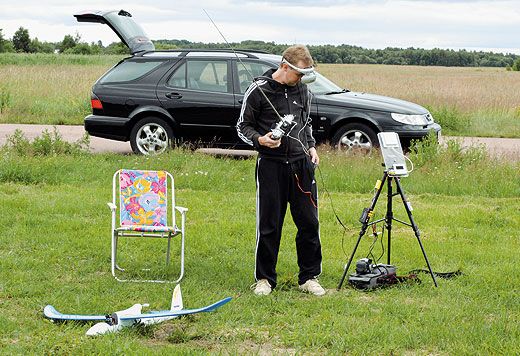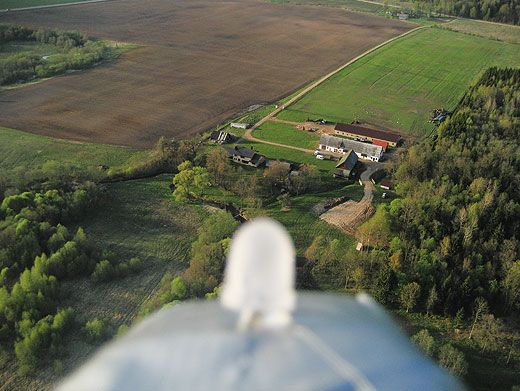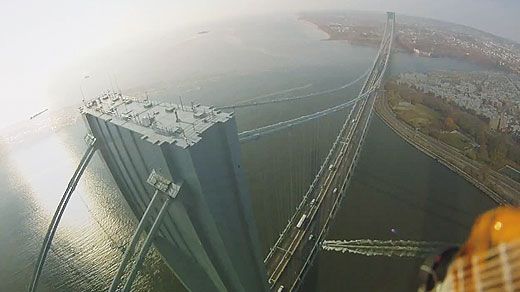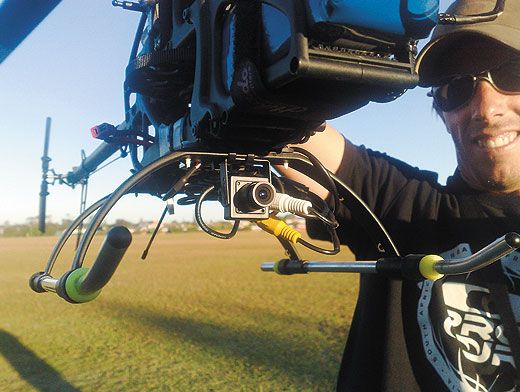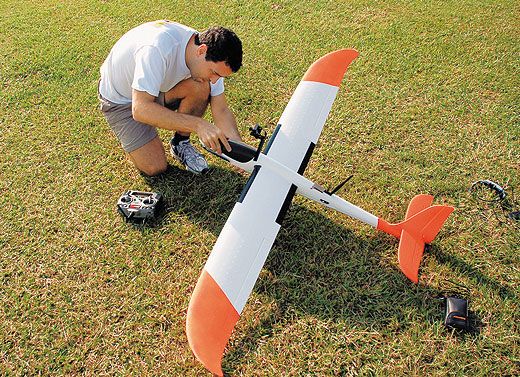Pilot Cam
A remote-controlled airplane, a camera, and a pair of goggles can put you in the (virtual) pilot’s seat for as little as $500
/https://tf-cmsv2-smithsonianmag-media.s3.amazonaws.com/filer/9d/5f/9d5fbb2f-eaa8-452b-bbe2-69403889b106/blacksheep-nyc.png)
Raphael Pirker used to fly traditional remote-controlled airplanes, but he can’t remember now what the thrill of it was. He no longer settles for watching model aircraft fly around over his head and thinking how much fun it would be to be up there soaring among the birds.
Now Pirker flies FPV, or First Person Video, using electronic goggles to watch video streaming in real time from a camera mounted on the airplane. In effect, it’s like being in the cockpit. His airplane, a flying-wing-style Zephyr with a 54-inch wingspan, is light and fast, with a top speed of 90 mph—ideal for feeding his addiction to high-speed aerobatics. Thanks to high-power transmitters and other clever gadgetry, Pirker has roamed as far as 27 miles from where he stands.
So where does he fly? Anywhere he wants. “It’s like, you know, you’re traveling,” says the 26-year-old business and IT student. Originally from Switzerland, he now lives in Austria, where he finds some pretty dramatic landscapes to fly over. “I don’t climb mountains. I don’t do a lot of hiking,” he says. “But with FPV I can just go places, and within five minutes I’m up on a 3,000-meter mountain.”
Most FPV pilots record their flights—and post the videos online—sometimes using a second, record-only camera that shoots in high-definition. The videos Pirker puts up are often of thrill rides: The camera shows the nose of his Zephyr as the airplane careens down the face of a cliff or zips between tall alpine trees, rolling its wings at the last possible moment to avoid a crash. Some of the adrenaline comes from knowing he’s got $2,000 worth of equipment rocketing around up there, inches from the rocks and miles out of his reach.
“You’re naturally nervous about losing [the airplane],” he says. “But at the same time you want to push the limits. There’s always the clash between fear and temptation in life.”
Pirker has a strong presence online, where he goes by Trappy. He and a friend, who calls himself RiSCyD (“Risky D”), are an informal flying duo called Team Black Sheep. Last December, Pirker stood in a park near New York City’s East River, put on a pair of goggles, and flew around the Brooklyn Bridge. Later, he guided his airplane to the Statue of Liberty and buzzed her head. Team Black Sheep recorded the whole thing on video and posted it online, stirring up a Web-wide buzz about the legality of the flight (but mostly about how cool the footage is). (Editor's Note: See the comment below from the President of the Academy of Model Aeronautics.)
We’ll get back to that legality question.
First Person Video is growing among RC hobbyists. Although a few pioneers had mounted film cameras to gas-powered aircraft in the 1970s, veteran FPV pilot Scott Sells says the modern hobby dates to the late 1990s, when cheaper and smaller video systems became available. The first rigs required expertise in electronics and radio transmission, but since then have become much cheaper and easier to use. Now, says Sells, an FPV system is simple to set up and straightforward to fly, and can cost as little as $500.
He got into FPV in 2003, when he was having trouble controlling his traditional RC helicopter. It was hard to keep track of the vehicle’s three-axis motion while looking at it from a distance. “I kept thinking, If I could just fly this thing from inside the cockpit, I’d have no problem.”
So, with some guidance from the then-new online FPV forums, Sells strapped a small security-industry camera to his little helicopter and started beaming video to a monitor. In no time he was a pro pilot.
Sells thinks it’s easier and safer to fly an RC aircraft from its own perspective. He likens traditional RC flying to trying to pilot a real airplane from the control tower. “I’ve had people I’ve tried to teach how to fly in the traditional RC view, and they just don’t get it,” he says. “You put the goggles on them and toss the plane for them, and next thing you know they’re flying it all over the place.”
Sells’ day job is fabricating off-road racing trucks for big races like the Baja 500, and his professional skills came in handy when he noticed that vibrations in his helicopter during flight were causing the video chip to separate from his onboard camera. Working in his home garage in Lake Elsinore, California, he started making lightweight, aluminum parts that dampened the vibrations.
Sells (who calls himself Crash9 online) posted about his improvements in the Web forums, and by January 2007 he was receiving so many messages from people wanting to get into the hobby that he decided to start his own site (fpvpilot.com) listing everything he’d learned about FPV. Now he custom-builds systems and ships them to buyers all over the world.
But, according to Sells, most people find they can put together the equipment themselves. “If you understand yellow wire goes to yellow wire, red wire goes to red, you’ll be fine with FPV. If you can hook up a VCR and program the clock on it, you can do this stuff with no problem.”
Both Pirker and Sells say one of the best things about FPV is the fun of exploring places that would otherwise be hard to visit. Pirker’s playgrounds are breathtaking—snow-capped mountains, waterfalls, an alpine ski resort. Sells covers the deserts, sometimes chasing off-road trucks racing around on slippery dunes. He recently flew the Grand Canyon, and like Pirker has posted dozens of FPV videos online.
As for whether stunts like Pirker’s New York flight are legal, Federal Aviation Administration regulations on FPV flying are still a gray area. The only FAA document related to model airplanes dates from 1981, and suggests that they should be flown below 400 feet (which Pirker interprets as 400 feet from the top of the highest structure) and no closer than three miles to an airport. They also should stay away from full-scale aircraft. But these aren’t regulations per se, and people who don’t follow the FAA’s suggestions haven’t technically broken the law.
“They’re violating guidance,” says Les Dorr, a spokesman at FAA headquarters in Washington, D.C. “It’s not mandatory, but we expect them to follow it.”
According to Dorr, a recent increase in model aircraft activity has prompted the FAA to form an Aviation Rulemaking Committee to take a look at Unmanned Aircraft Systems, particularly small ones like those flown by Pirker and Sells. The committee will produce a set of regulations addressing those aircraft later this year.
Fans of FPV insist that in the right hands, the hobby is safe. According to Pirker, Team Black Sheep has never had a single technical failure. That’s because he and RiSCyD check their equipment thoroughly every time they fly, and replace systems twice as often as the manufacturers recommend. FPV fliers have their own strict code of safety (like no flights in airspace that can’t be monitored by a spotter), which, Pirker admits, he follows more faithfully than official Austrian government rules. European regulators “are very uptight about FPV,” he says. “As soon as we take off, it’s already a gray zone.” Besides, permits in Austria are prohibitively expensive for hobbyists.
On the online forums, some commenters say that Pirker’s free-roaming New York flight suggests that FPV could be used by terrorists. Sells dismisses the worry. Building a remote-controlled aircraft large enough to carry a harmful payload would be more trouble than it’s worth, he says. Building a full-size airplane would be easier.
During his New York flights, Pirker was approached several times by the National Park Service and New York police, but they just ushered him somewhere else. “We were told we were not allowed to fly in Liberty State Park, so we flew from a different location,” he says. One officer even admitted that he was an avid RC pilot himself, and was excited to see Pirker’s cool setup. Pirker thinks that stroke of luck may have saved him the headache of trying to explain why his airplane didn’t pose a threat to the city.
Judging by the number of visitors to Sells’ Web site—500 to 700 a day—interest in flying by video is already robust. Hits on the site have tripled in the past two years, and the traffic is still growing. According to Sells, the majority of FPV enthusiasts live in the United States and Australia, but there are sizable communities in Europe as well. As for whether there’s real money to be made, Sells thinks the movie industry, for one, could become a big user of FPV footage. “I mean, if you could fly a camera through a room, out the window, up a high-rise, and come back…” He trails off in mid-sentence, just thinking about the possibilities. “You can’t do that with a crane or anything else.”
Pirker plans to keep pushing the envelope of high-speed, spectacular FPV flying. He and RiSCyD want to perfect the art of tandem flights: standing side by side on the ground, with each (virtually) flying his own airplane. They also have two ambitious FPV goals for this year. “The first is going to space…with a balloon,” Pirker says. “The second one is, we’re actually looking for funding to go to the Himalayas and fly Mount Everest.” For that they’ll need a bigger Zephyr, with more wing surface to create lift in the thin air above 29,000 feet.
As for Sells, he seems to have an endless list of potential uses for FPV. Geologists could use it to study land formations. Lost hikers could use it to orient themselves. Anyone could see the massive ancient designs on the desert floor in Nazca, Peru, without having to buy a seat on an airplane. Sells himself is content just to take his helicopters to the lake with his family, or explore the desert near his home.
The biggest advantage of flying from the ground may be just that: staying on solid ground. Sells tried to get a pilot’s license in 2002, but had to give up lessons due to motion sickness. Pirker, the FPV mountain surfer, has never flown a full-scale airplane either. Would he want to? “Never,” he says. “I’m afraid of heights.”
WHAT YOU’LL NEED
The gear for First Person Video is pretty simple. First you need an aircraft, something large and sturdy enough to house a small camera. Most mid-size remote-controlled airplanes with a wingspan of a few feet can handle the payload (which can include an extra battery to extend flight time). Then you need a transmitter to send the video signal from the airplane and a receiver on the ground. And you need a wireless controller to fly the airplane.
To display the video, you can use either goggles (for a virtual reality feel) or a flat monitor with a sun visor to cut the glare. The advantage of the monitor is that you can easily look up and locate the aircraft in the sky.
Everything you need for FPV is available through several online sites, some of which are listed at right. After you have the necessities, you may want to upgrade with a few add-ons. For instance, head-tracker goggles sense the movement of your head and translate that motion to the airplane’s camera, so you can “look around” while flying. There’s also OSD, or on-screen display, which overlays information like battery life, signal strength, and GPS coordinates on your video image. A cheaper way to monitor this information is to mount a small LCD battery-life indicator on the airplane itself, within view of the camera.
Another option is the “return home” capability. If the airplane accidentally flies out of range and you lose signal, an onboard processor reads the GPS location and flies the airplane back toward you until you can take control again. Pretty sweet.
For the most part, FPV systems are still do-it-yourself, with the pilots assembling the parts. If you have no previous experience, don’t expect to jump right in; you might have to do some soldering, and it wouldn’t hurt to get a ham radio license so you know how to get the most out of your transmitter frequencies. Team Black Sheep is now offering an almost-ready-to-fly FPV Zephyr kit on its Web site for $1,999, with no soldering required (team-blacksheep.com/products/product:3). But big RC manufacturers are likely to catch up in this market soon, so keep an eye out for all-in-one, pre-made FPV aircraft that you will be able to fly right out of the box.
- A good introduction to FPV:
- fpvpilot.com/GettingStarted.aspx
Places to buy FPV gear online: - eagletreesystems.com
- dpcav.com
- readymaderc.com
Online FPV and RC forums: - rcgroups.com
- fpv-community.com
